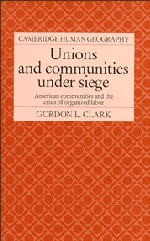Book contents
- Frontmatter
- Contents
- List of tables
- Preface
- Acknowledgments
- PART I ECONOMY AND COMMUNITY
- PART II DRAMA OF ECONOMIC RESTRUCTURING
- PART III UNION PERFORMANCE IN REPRESENTATION ELECTIONS
- 5 Democracy in the guise of representation elections
- 6 Organizing strategies in the heartland and the South
- 7 At the margin of the rules of the game
- PART IV REGULATING LOCAL LABOR–MANAGEMENT RELATIONS
- PART V PROSPECTS FOR ORGANIZED LABOR
- Appendix 1 Variables and data sources
- Appendix 2 Cases cited
- Notes
- Bibliography
- Name index
- Subject index
5 - Democracy in the guise of representation elections
Published online by Cambridge University Press: 13 October 2009
- Frontmatter
- Contents
- List of tables
- Preface
- Acknowledgments
- PART I ECONOMY AND COMMUNITY
- PART II DRAMA OF ECONOMIC RESTRUCTURING
- PART III UNION PERFORMANCE IN REPRESENTATION ELECTIONS
- 5 Democracy in the guise of representation elections
- 6 Organizing strategies in the heartland and the South
- 7 At the margin of the rules of the game
- PART IV REGULATING LOCAL LABOR–MANAGEMENT RELATIONS
- PART V PROSPECTS FOR ORGANIZED LABOR
- Appendix 1 Variables and data sources
- Appendix 2 Cases cited
- Notes
- Bibliography
- Name index
- Subject index
Summary
On 19 June 1935, the Committee on Rules debated House Resolution 263 – a resolution to report the Wagner Act to the floor of Congress for final approval. In that debate House members sought to clarify and defend provisions of the Act. While doing so Representative Mead (D – New York) said, in part, that the Act “creates a democracy within industry which gives our industrial workers the same general idea of freedom which the founding fathers conferred upon citizens of the United States. It prohibits force and intimidation and leaves men to organize or remain unorganized as they shall desire.” At the time, Representative Mead's interpretation of the Act, electoral democracy for industry, was one amongst a number of competing and complementary interpretations. Since passage of the Taft–Hartley amendments in 1947 it is now assumed that this interpretation was central to the Act. Indeed, Stone (1981) suggested that as representation elections mimic partisan political elections, the Act embodies a fundamental ideal of American liberalism: local electoral choice.
President Roosevelt noted in signing the Wagner Act into law that it “[establishes] the right of self-organization of employees in industry for the purpose of collective bargaining, and provides methods by which the government can safeguard that legal right.” The National Labor Relations Board was the federal agency charged with the responsibility of holding representation elections and adjudicating appeals over conduct of the electoral process. These elections are the life-blood of any union.
- Type
- Chapter
- Information
- Unions and Communities under SiegeAmerican Communities and the Crisis of Organized Labor, pp. 91 - 109Publisher: Cambridge University PressPrint publication year: 1989



